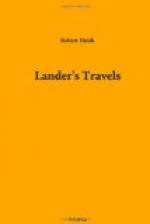In consequence of these amicable dispositions evinced by the bashaw of Tripoli towards the British government, it was resolved to appoint a vice-consul to reside at Mourzouk, the capital of Fezzan; and the late Mr. Ritchie, then private secretary to Sir Charles Stuart, the British ambassador at Paris, was selected for the undertaking. He was joined at Tripoli by Captain G. F. Lyon, who had volunteered his services as his companion; and to this enterprising and more fortunate traveller, who has braved alike the rigours of an Arctic winter, and the scorching heats of central Africa, we are indebted for the narrative of the expedition.
On the 25th March 1819, the coffle, (kafila, kefla,) consisting of about two hundred men, and the same number of camels, commenced its march from Tripoli for the interior. They were accompanied by Mohammed el Mukni, the sultan of Fezzan, from whose protection and friendship the greatest advantages were anticipated. By the express advice of the bashaw, the English travellers assumed the moorish costume, with the character of Moslem. Mr. Ritchie’s name was converted into Yusuf al Ritchie; Captain Lyon called himself Said Ben Abdallah; and Belford, a ship-wright, who had entered into their service, took the name of Ali. In the coffle were several parties of liberated blacks, all joyful at the idea of once more returning to their native land, though the means of their support were very slender, and many of them, with their young children, had to walk a distance of two thousand miles before they could reach their own country.
The route lay for the first two days over a sandy irregular desert, and then entered the mountains of Terkoona, situated to the south-east of Tripoli, and which seems to be a continuation of the Gharian or Wahryan range. Several little streams flow from the sides of the hills, abounding with game, particularly snipes and partridges. On the sixth day, passing over a stony desert, they reached Benioleed, an Arab town, with about two thousand inhabitants. It consists of several straggling mud villages, on the sides of a fertile ravine, several miles in length, and bounded by rocks of difficult access. The centre is laid out in gardens, planted with date and olive trees, and producing also corn, vegetables, and pulse. The valley is subject to inundation during the winter rains, but in summer requires to be watered with great labour, by means of wells of extraordinary depth. It is inhabited by the Orfella tribe, subsisting chiefly by agriculture, and the rearing of cattle, aided only in a trifling degree by a manufacture of nitre; they are accounted hardy and industrious, but at the same time dishonest and cruel. Benioleed castle stands in latitude 31=B0 45’ 38” N., longitude 14=B0 12’ 10” E.




